 General Information
General Information
Author:
Lutz Pietschker
Version: 2018-05-07
Paper Modelling | Home Page | Links | What's New
 General Information
General Information
On this page I collect dragon models from different publishers:
(Click image to show it in large size in a new window.)
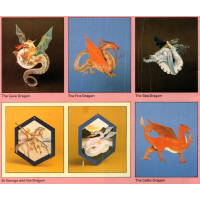
|

|
There are five dragon models in this book, as shown in the first picture (St. George has a back and front view). The cave dragon went AWOL, I can't say where the beast has gone, probably I used it as a gift wrapping accessory or something like that.
The book is about A4 size (30x21 cm), and each dragon has two to four pages to himself. The image to the right shows the fire dragon in a special mission– the little beauty had the honour to decorate the posters and flyers of the Topmodels 2010 paper model exhibition in the Schwedenspeicher museum in Stade. A proud moment for me, indeed! |

|

|
The fire dragon is, I think, the most impressive of the lot, with its beautiful twisted tail and fiery mane, spouting fire. Its overall size is 30 cm. |

|

|
Two more views from the front, showing the head and the wing span. |

|

|
And two more. Doesn't it look outright wicked in the right picture? You would not guess what a friendly animal it actually is (unless you try to steal its treasures, of course). |

|

|
Here you see the water dragon. It has two heads and a sharp bow to part the waves. My wife made it while I did the fire dragon. Both models were used as decoration in our small stage when we had "dragonish" stories in the program. |

|

|
This model is a relief model of St. George attacking (on one side) the dragon (on the other side). Must have been somewhat hard to hit the dragon that way, but also a bit safer I think. |

|

|
The "fire dragon" automation by
Walter Ruffler
was built by my wife, actually it was one of the first "seriuos" paper models she built.
The dragon comes on 4 sheets A4, plus instructions. The set comes ready to build, with all wooden axles etc. included. Another nice model designed by a master of automata. |
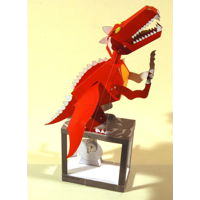
|
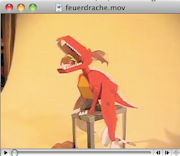
|
When the crank is turned, the dragon rears, raises his arms and wings, and shuts its snout. The main motion comes from a simple crank that raises the dragon's head and body, the secondary movements come from threads that act against that motion.
The last images links to a small movie (230 kB) that shows the dragon in action. Seems that a bit of adjusting still needs to be done. |
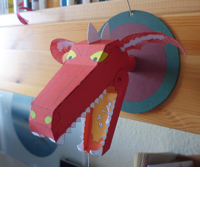
|
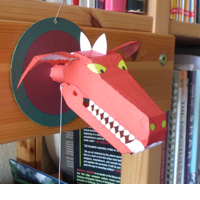
|
The Dragon's Head automation by Walter Ruffler would be a nice trophy for role-players of the D&D kind. It shows an impressive open maw (with some leftover bones in it); it shuts when you pull the string. |
As the author of this page I take no expressed or implied responsibility for the content of external links; opinions expressed on such pages are not necessarily mine. The web space provider is not responsible for the contents of this page or any linked pages.
Written and published by Lutz Pietschker. Please send comments about technical problems to the
site master.
-Made with a Mac!-
, last change 2018-05-08